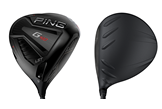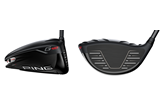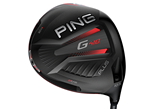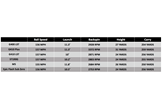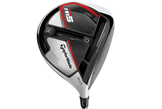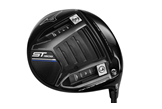Do I need a low spin driver?
Published: Last updated:
Back in January Ping pulled the covers off the new G410 family, and it was well documented at the time how there was no low-spin (LST) driver, like previous line-ups.
The reason was simple – when Ping engineers started testing the intended new model, they realised it didn’t offer a big enough improvement over the existing G400 LST. So they went back to the drawing board, and stayed there until they came up with a model which bettered the previous offering.
It’s taken six months, and plenty of head scratching, but the new G410 LST was recently unveiled. So now seemed like the perfect time to put it up against the best low-spin drivers of 2019 (as well as the previous G400 LST and Ping’s current G410 Plus driver) to see how the latest models compare.

Ping G410 LST driver: Need to know
Ping’s latest LST driver is tailored to the type of player it typically suits. A “tour square” face means the head naturally sits open. The head is 450cc, 5cc smaller than the G410 Plus, and there’s a rounder, more pear-shaped profile than the G410 Plus.
The LST lowers spin by 200-400rpm (over the Plus) and it has a three per cent higher MOI than the previous G400 LST. Unlike any low-spin Ping driver before, you can dial in shot shape by up to 20 yards, thanks to a movable weight, and draw/fade/neutral port positions.
The details:
RRP: £450
Lofts: 9º / 10.5º
Stock shaft: Ping Tour 65/75, Ping Alta CB Red, Mitsubishi Tensei CK Orange, Even Flow Black
Adjustable hosel: +/- 1.5°

ROBOT TESTED: Which golf ball suits my game?
Ping G410 LST driver: Verdict
To be fair to Ping it’s not really a surprise to see them struggle to improve the G410 LST, as the old model was a great driver in the right hands. But incredibly, our data reveals Ping has wrung out a fraction more ball speed, lowered spin a little and upped carry distance a smidgen in the new model.
Admittedly, probably not enough to convince most G400 LST owners to consider an upgrade, but then that’s not the intended audience. The face angle being slightly open speaks volumes about the type of player this club is aimed at – for most club golfers it will exaggerate a slice.
Six yards of carry distance difference and 2mph of ball speed drop-off covers all our low-spin drivers, which tells us that if you’re in the market for less spin, there’s not a huge amount to choose between them, as long as you get properly fitted.
Should you try one?
We can’t stress enough that low spin drivers are not for everyone. Ping says less than 10% of the drivers they sell will be low-spin models, which backs up our thinking. Even our test pro, who played off +4 before turning pro, prefers playing with a slightly higher spinning driver as he feels it helps him find more fairways.
It’s easy standing on a launch monitor, chasing low spin, watching intently as ball speeds and carry distance numbers increase. What many players don’t pay attention to, though, is how less spin also makes it harder to hit straighter drives, and therefore find fairways.
Generally, low-spin models perform better in the hands of harder hitters (with higher swing speeds) and possibly golfers who hit down on the ball with a driver. Think about choosing a low-spin model like opting for a set of muscleback irons over cavity backs; if your game can manage it, you won’t go too far wrong with any of the drivers here.
The numbers:

Up against:
Review: Ping G410 Plus driver

RRP: £450
Lofts: 9º / 10.5º / 12º
Stock shaft: Ping Alta CB Red, Ping Tour 65/75, Project X Even Flow Black, Mitsubishi Tensei CK Orange, Ping Alta Distanza
Adjustable hosel: +/- 1.5°
Not aimed at the low-spin market, but from our experience a model that can suit golfers from hard hitters to players who might have used a draw biased model before. For our test pro the combination of fast ball speeds, extra launch and more spin helped keep shots in the air for longer.
TESTED: Titleist Pro V1 vs TaylorMade TP5 golf balls
Review: Mizuno ST190G driver

RRP: £449
Loft: 9º
Stock shaft: Fujikura Atmos Blue 5S, Atmos Red 5RS and Atmos Black TS 6S
Adjustable hosel: +/- 2°
A driver that chases low spin. It wasn’t until we photographed the ST190G on a slanted table that we realised just how much weight is located low and forward. Whereas other driver heads sat upturned, the ST190G had a natural tendency to fall on its face, showing just how much weight is positioned to manage spin. Naturally, it means a drop-off in forgiveness.
TESTED: Which Mizuno iron suits me?
Review: TaylorMade M5 driver

RRP: £499
Loft: 9º / 10.5º / 12º
Stock shaft: Mitsubishi Tensei Orange
Adjustable hosel: +/-2°
A driver you’ll see in many top players bags including Tiger, Rory and DJ. The T-Track sliding weight system offers 20g of mass to position to personalise spin, launch and shot shape. And that’s a lot of weight to put low and forward in a driver head (600rpm and a degree of launch change in fact) if you want to chase low spin and distance at all costs.
TESTED: Why shaft weight is now more important than flex
Review: Callaway Epic Flash Sub Zero driver

RRP: £499
Lofts: 9º / 10.5º
Stock shaft: Project X Even Flow Green, Mitsubishi Tensei AV Blue, Project X HZRDUS Smoke
Adjustable hosel: -1/+2°
Our longest low-spin driver in this test. The Flash Face was designed by machine learning, and comes with a very different sound to the standard Epic Flash. Jailbreak tech allows the head to take on more impact load, so it’s no surprise the Sub Zero is fast, long and a favourite on Tour.



